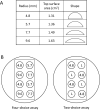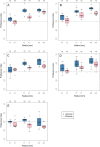Drosophila suzukii preferentially lays eggs on spherical surfaces with a smaller radius
- PMID: 36138089
- PMCID: PMC9500074
- DOI: 10.1038/s41598-022-20022-z
Drosophila suzukii preferentially lays eggs on spherical surfaces with a smaller radius
Abstract
Drosophila suzukii is an agricultural pest that predominantly harms small fruits, having a serrated ovipositor that is able to pierce the skin of ripening fruits. Its oviposition preference has been studied from various aspects including chemical and physical properties of oviposition substrates. However, its preference for certain shapes or sizes of substrates has not been explored. In this study, we tested the oviposition preference of D. suzukii for artificial oviposition substrates with different surface curvatures using 27 strains recently established from wild populations collected in Japan. We found that D. suzukii laid more eggs on a surface with smaller radii (4.8 and 5.7 mm) compared with larger radii (7.7 and 9.6 mm). We also found that the most preferred radius differed among strains. Notably, the preference was independent of the volume of substrates, suggesting that D. suzukii uses the surface curvature as a cue for its oviposition site selection. These results provide an additional explanation for why D. suzukii preferentially uses small fruits as its oviposition sites.
© 2022. The Author(s).
Conflict of interest statement
The authors declare no competing interests.
Figures




References
-
- Walsh DB, et al. Drosophila suzukii (Diptera: Drosophilidae): Invasive pest of ripening soft fruit expanding its geographic range and damage potential. J. Integ. Pest Manag. 2011;2:G1–G7. doi: 10.1603/IPM10010. - DOI
-
- Hamby KA, et al. Biotic and abiotic factors impacting development, behavior, phenology, and reproductive biology of Drosophila suzukii. J. Pest Sci. 2016;89:605–619. doi: 10.1007/s10340-016-0756-5. - DOI
Publication types
MeSH terms
LinkOut - more resources
Full Text Sources
Molecular Biology Databases

